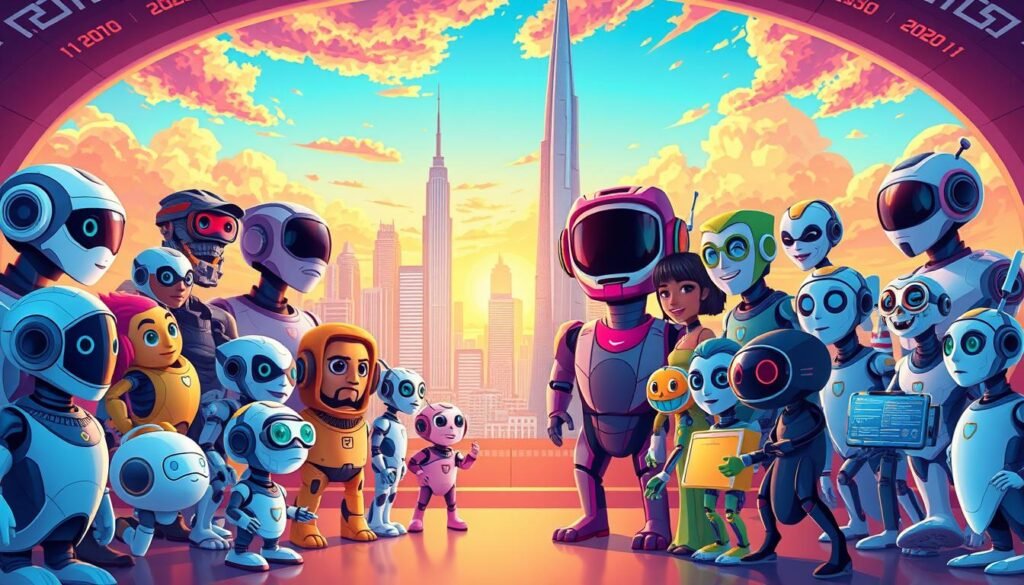Character AI Alternative: Finding the Best Options for Richer Conversations
Character AI alternatives can truly offer richer conversations, fewer creative blocks, and more flexibility. In this guide, we explore the best platforms for users who want deeper immersion, faster replies, and broader media support.
We’ll show you who each alternative best serves, how they handle character creation, and which features make the biggest difference in daily use. From storytelling and roleplay to companionship, onboarding is made smooth and rewarding.
You’ll also see clear trade-offs—pricing, memory, limits, and accessibility—along with practical insights on free tiers, trials, and premium upgrades. Our approach is professional and reassuring, with data-backed highlights and actionable steps so you get the most from your first chat.
Key Takeaways
- Quick roadmap: pick the right platform fast.
- User outcomes: better immersion, continuity, and speed.
- Feature focus: memory, voice/image support, and control.
- Practical access: free tiers, trials, and smooth upgrades.
- Clear trade-offs: pricing, limits, and moderation styles.
2025 outlook: advanced AI conversations, fewer limits, better control
The landscape in 2025 emphasizes control: better memory, moderation toggles, and richer media that make chat sessions feel more real. Testers note a clear shift toward platforms that let you manage tone, safety, and recall without sacrificing speed.

Users now expect natural voice options, editable replies, and multi‑character scenes. Vendors advertise faster responses, higher uptime, and selectable models or APIs to balance cost and performance.
Privacy and data control are stronger. Many platforms publish retention policies and enable encrypted transport by default. That gives you tangible control over what stays and what is deleted.
- Continuity: smarter context handling and persona stability for long chats.
- Moderation: toggles let you set roleplay intensity and guardrails.
- Capabilities: voice calls, image support, and steerable replies improve interactions.
Expect rapid iteration: weekly UX updates and model refreshes that reduce friction and save time for both new and power users.
Character.AI at a glance: strengths and where it falls short
Let’s examine the platform’s core strengths and the practical limits you’ll notice day to day. The service grew fast because it makes custom persona creation simple and invites community sharing. Many users love the mobile apps and the wide library of playful and educational characters.
Key features that won fans:
- Free access with easy character creation and strong community discovery.
- Human-like interaction for quick entertainment and proto‑storytelling.
- Polished mobile apps that keep discovery and chat smooth.

Common pain points for power users
Practical drawbacks matter. Strict NSFW filters often stop mild themes, which frustrates long-form roleplayers. Memory limits make deep continuity harder — the system can forget earlier context during long scenes.
Free users report slower replies at peak times; upgrading to Plus ($9.99/month) gives priority and faster response. There’s no self-hosting option, so all data stays on company servers and export or deletion controls are limited. Frequent interface tweaks also disrupt some workflows.
Bottom line: Excellent for discovery and casual use, but these limitations push creators toward platforms that offer more control and stronger memory for long narratives.
How to choose the right chatbot platform for your needs
Begin by defining the role you want a chatbot to play in your workflow or leisure time. Pin down your main needs: writing, long‑term companionship, or open roleplay. That clarity makes comparisons fast and precise.

Customization depth: personality, settings and multi‑character scenes
Customization matters when you need consistent tone and behavior. Look for personality sliders, steerability, and multi‑character modes. Platforms like AI Dungeon support multi‑character scenes, while Kajiwoto lets you train companions with datasets.
Memory and emotional intelligence
Seek summary memory, callbacks, and empathetic replies. These features keep long sessions coherent and build trust. Test how well a platform recalls details across hours or days.
Moderation, privacy, and data control
Control over filters and storage is essential. Favor systems with adjustable NSFW filters and private characters. Janitor AI and similar services offer model selection via API and clearer export or deletion options.
“Start with what you need, then match features to that goal.”
- Start with use case: set priorities before testing.
- Try creators’ tools: importing datasets or prompt tweaking helps power users.
- Test UX speed: fast interaction reduces friction and improves flow.
Understanding pricing models before you commit
Before you subscribe, map costs to the features you actually need. Pricing affects access, the quality of responses, and how much time you spend managing limits. Treat cost tiers as a workflow decision, not just a sticker price.
Free tiers and subscriptions: message caps, faster responses, premium models
Free plans let users try platforms with low risk. Expect message caps, slower responses at peak time, and limited model choices.
Paid subscriptions unlock faster responses, priority queues, and better model options. Examples: Plus plans at $9.99/month, Candy AI at $12.99/month (or $71.88/year), HeraHaven at $19.95/month ($119.95/year), and tiers like GPTGirlfriend at $15–$50/month. NovelAI starts near $10/month; AI Dungeon offers paid plans from ~$9.99/month.
Pay-as-you-go credits: voice, images, and add‑ons
Many services separate core access from media. You may buy credits for voice or image generation, token packs from $9.99 to $299.99, or scene add-ons. For light users, pay‑as‑you‑go often costs less than a subscription.
- Compare monthly vs annual: annual plans reduce cost if you use the tool frequently.
- Watch promos: starter bundles extend testing without full commitment.
- Factor extras: third‑party API calls raise your total cost of ownership.
Bottom line: read the fine print on message limits and media rates so your monthly spend is predictable. Choose the plan that matches your content goals and real usage patterns.

Top Character AI alternatives for 2025: curated picks by use case
Below is a curated shortlist of top platforms organized by how people use them. Each pick highlights the core features and the typical user outcome so you can match a tool to your workflow.
AI Dungeon — immersive storytelling and group interactions
Best for: open‑ended plots and multi‑player scenes. Sandbox design lets you run campaigns where characters react like a Dungeon Master.
NovelAI — writer‑grade prose with strong memory and image generation
Best for: authors who want polished text and persistent recall. Includes image generation and voice options for richer scenes.
CrushOn AI — polished, unfiltered conversations with a huge character library
Best for: fast, natural chat and wide discovery. Generous free plan and a searchable library make it easy to find familiar personas.
Janitor AI — flexible models via API and vibrant roleplay community
Best for: power users who want model choice and a strong community. API access and experimental LLMs give control over tone and content.
SpicyChat — straightforward NSFW roleplay with fast onboarding
Best for: adult roleplay with minimal setup and a large catalog of scenes. Subscription unlocks more unfiltered interactions.
Charstar AI — mobile‑first, fast, and simple for creative freedom
Best for: quick mobile chats and on‑the‑go creation. Clean UX and an ad‑supported free tier speed you to fun.
Kajiwoto — build and train companions with datasets and image tools
Best for: builders who train companions. Import datasets, tune behavior, and pair with images for personalized content.
Chai AI — community feed for quick, casual, less‑filtered chats
Best for: social discovery and short interactions. The feed keeps conversations fresh rather than long arcs.
Replika — emotional support, memory, and wellness activities
Best for: daily support and consistent recall. Memory features and guided activities focus on care and steady support.
Anima — hybrid friend/roleplay with toggleable modes
Best for: users who switch between casual friendship and roleplay. Toggles let you shift mood quickly without rebuilding personas.
“Choose a platform that fits the session you want—story, support, or social.”
Editor’s hands‑on best alternatives: depth, personality, and control
We spent hours with each service to judge personality, customization, and real‑world privacy. The goal: find platforms that give rich tone, steady memory, and useful media without heavy setup.
Candy AI — emotionally aware chats and media
Price: $12.99/month or $71.88/year. Tokens $9.99–$299.99.
Standout: emotional conversations, image generation, voice messaging, NSFW toggles, and deletion controls.
Kupid AI — memory, scenes, and multiverse play
Price: from ~$10/month.
Standout: robust memory, an emotion engine, scene creation, and multiverse timelines. Voice chat is in beta.
DreamGF — visual‑first companion
Price: ~ $9.99/month plus credits.
Standout: strong visuals, NSFW images, quick personalization, and voice replies. Memory is lighter but immersion is fast.
GPTGirlfriend — tiers for deeper control
Plans: Premium $15, Deluxe $35, Elite $50 per month.
Standout: advanced customization options, voice tiers, media sharing, and stronger recall at higher plans.
HeraHaven — privacy and fast setup
Price: $19.95/month or $119.95/year.
Standout: chat‑matched visuals, quick onboarding, memory, voice beta, and end‑to‑end encryption.
- Quick summary: Candy AI excels at emotional content and media.
- Kupid AI is best for long arcs and scene building.
- DreamGF favors visuals and fast immersion.
- GPTGirlfriend gives deep customization for power users.
- HeraHaven focuses on privacy and a clean experience.
Tip: Choose based on how much you value visuals, memory strength, and voice presence in daily chats.
Character AI alternative: switching for better conversations
Switching platforms can unlock richer, more reliable conversation and reduce the friction that stops creativity. Many users move when strict filters, memory gaps, or slow peak‑time replies interfere with workflows. The right move restores momentum and gives you practical control over how your chats behave.
Who should switch
Roleplayers, creators, and heavy users who need fewer restrictions will benefit most. If long sessions lose context or filters interrupt scenes, switching can help. Writers who build arcs and users running multi‑character scenes also gain from stronger memory and scene tools.
What you gain
Practical gains include better customization, NSFW toggles, stronger memory, and richer voice/image features. Faster chat at peak hours improves session flow. You also get clearer access and privacy choices—pick a platform with deletion controls or self‑host for full data custody.
“Export your core notes, define goals, and trial two platforms to find the best fit.”
- Flexible moderation: restore creative flow when filters break scenes.
- Scene tools: memory and multi‑character setups add depth to storytelling.
- Media: voice and images make content feel immediate and alive.
- Performance: faster responses and better access during peak hours.
- Privacy: clear deletion controls or DIY hosting for max control.
| Issue | Gain after switch | Typical users helped |
|---|---|---|
| Strict filters | Adjustable moderation, NSFW toggles | Roleplayers, writers |
| Memory loss in long chats | Persistent memory, summaries | Storytellers, long‑term users |
| Slow peak responses | Priority tiers, faster servers | Active communities, creators |
| Lack of private hosting | Self‑host or clearer deletion policies | Privacy‑minded users, devs |
Privacy and control: from platform policies to self‑hosting
For many users, moving to a self‑hosted stack is the clearest path to full privacy and control. If you value keeping conversations local, open‑source setups remove third‑party servers from the loop.
DIY options like Pygmalion, SillyTavern, and KoboldAI form a practical stack. Pygmalion supplies a runnable model. SillyTavern and KoboldAI act as flexible front‑ends with advanced settings.
These tools are free but require work. Expect GPU needs or a cloud VM, API keys in some flows, and manual file management for saved sessions.
Platform data policies to check
- Encryption: transport encryption is common, but storage practices differ.
- Deletion & export: confirm whether a provider offers simple deletion and data portability.
- Hosting limits: managed platforms may block self‑hosting; local stacks avoid that constraint.
Performance depends on your hardware. DIY can be fast, but interaction volume and model size affect latency. For non‑technical users, prefer services that publish clear policies and let you adjust logs and retention.
“If privacy is critical, run models locally and keep content under your control.”
| Option | Privacy level | Ease of setup |
|---|---|---|
| Pygmalion + SillyTavern | High (local) | Moderate to hard |
| KoboldAI (local) | High (local) | Moderate |
| Managed platforms | Variable | Easy |
Match the platform to your goals and interactions
Match your tool to the task—each platform excels at a different type of interaction. Pick based on the outcome you want: creative depth, steady companionship, or technical control.
Writers and storytellers: sandbox freedom and literary output
Writers who want open worlds should try AI Dungeon for sandbox play. For polished prose and image-enhanced scenes, NovelAI fits text-driven projects well.
Companionship and emotional support: consistency, empathy, and activities
Users seeking daily care or guided activities do better with Replika for steady routines and Anima for toggleable modes. Both focus on empathy and emotional support.
Developers and power users: APIs, integrations, and model selection
Power users and devs need APIs, dataset imports, and model choice. Look to Janitor and Kajiwoto for toolkits that support prototyping and deep customization.
- Fast discovery: Chai’s feed gets users chatting in seconds.
- Align features: match personality controls to your needs.
- Validate support: check docs, community, and help channels before committing.
| Goal | Suggested platform | Key benefit |
|---|---|---|
| Sandbox storytelling | AI Dungeon | Open scenes, player-driven plots |
| Polished writing + images | NovelAI | High-quality text, image generation |
| Daily companionship | Replika / Anima | Consistent memory, activities, empathy |
| Developer prototyping | Janitor / Kajiwoto | APIs, datasets, model selection |
“Keep your goals visible—creativity, connection, or prototyping—and pick the platform that matches.”
Voice, images, and multimodal experiences
Adding voice and images turns simple replies into immersive scenes. This shift gives you richer presence and faster ways to convey mood. Platforms now bundle voice messaging, image generation, and galleries so users can mix media in a single session.
Voice chat and calls: immersion and real‑time presence
Voice adds a sense of presence. Short delays and clear response timing keep immersion intact during real‑time interactions.
The quality and capabilities vary: Candy AI offers voice messaging, Kupid AI has voice chat in beta, and DreamGF supports voice replies. Test latency, accents, and clarity before you commit.
Image generation and galleries: visual scenes and character art
Image tools create character art, scene backdrops, and mood boards. NovelAI and Kajiwoto integrate image generation and let you save outputs in galleries for reuse.
Practical note: many features use credits. Plan spend for voice notes, calls, and image batches. Confirm content policies for NSFW media and set controls to your comfort level.
- Blend modalities: combine chat, voice, and images to reduce text load and heighten the experience.
- Galleries: revisit visuals, refine prompts, and keep a consistent aesthetic.
- Capabilities: test quality and cost before you upgrade.
Multimodal fluency is a key differentiator in 2025 for believable companion experiences.
Community, interface, and overall experience
Strong communities and a clean UX turn a good service into a daily habit for users. Social feeds, leaderboards, and rating systems make discovery fast. Chai uses a feed and leaderboards; Janitor and CrushOn host large character libraries. Charstar focuses on mobile speed.
The right interface reduces friction. Clear menus, sample chats, and guest modes let you test access without commitment. Mobile apps on Android and iOS shorten the path from install to play.
Good community tools raise quality. Tags, ratings, and curated lists surface standout characters quickly. Moderation and guidelines shape the vibe so you find spaces that match your style.
Discovery, UX, and mobile apps: speed to fun and creative flow
- Fast discovery: feeds and templates speed onboarding.
- Low friction: intuitive interface keeps sessions focused.
- Feature discoverability: tutorials and tips boost results.
Experience matters: small UX refinements improve navigation and chat readability. For most users, the combo of community, app quality, and clear features is what keeps them coming back.
Performance and memory depth in long chats
When chats run for hours, latency and memory depth decide the outcome. Slow responses interrupt flow and break immersion quickly.
Practical testing shows free users report slower replies at peak time, while paid tiers and some platforms advertise faster models and better uptime. NovelAI emphasizes memory quality; Kupid highlights callbacks and evolving relationships. DIY stacks depend on your local hardware for latency and throughput.
Latency, uptime, and continuity: keeping immersion intact
Keep these operational priorities in mind:
- Low latency preserves pacing—small delays kill the mood in long conversations.
- Memory depth drives continuity; summaries and selective recall keep a persona true to intent.
- Faster replies keep energy high; premium tiers often offer queue priority for consistent performance.
- Model choice affects style and stability—test a few to find the best fit for your scenes.
- Save data responsibly; export transcripts to port arcs or restore context elsewhere.
- Use features like pinned lore, world notes, and memory slots to protect tone over long arcs.
“Monitor performance during your usual hours—peak loads vary by region and vendor.”
Conclusion
,After testing top picks, clarity matters: know which platforms deliver steady responses and which focus on visuals or privacy.
Editors’ top choices include Candy AI, Kupid AI, DreamGF, GPTGirlfriend, and HeraHaven for memory, voice, visuals, and data controls. Broad picks such as AI Dungeon, NovelAI, Janitor, and Replika cover storytelling, polished prose, developer tools, and emotional support. DIY stacks (Pygmalion, SillyTavern, KoboldAI) suit users who want full local privacy.
Next steps: trial two chatbot platform options side by side. Check pricing, moderation settings, and data deletion. Compare features, responses, and community vibe before you invest time building long chats. Pick the platform that fits your goals and enjoy better conversations, control, and experience.



